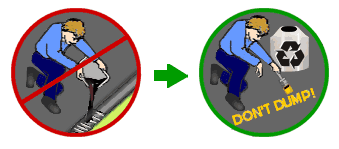Nonpoint Source Pollution Awareness: What's Wrong with This Picture?
The people below are taking care of their home and car, but they are doing many things that can damage the environment, especially our water.
Click on the places where you think someone's activities might be harming the environment and find out if you are right.
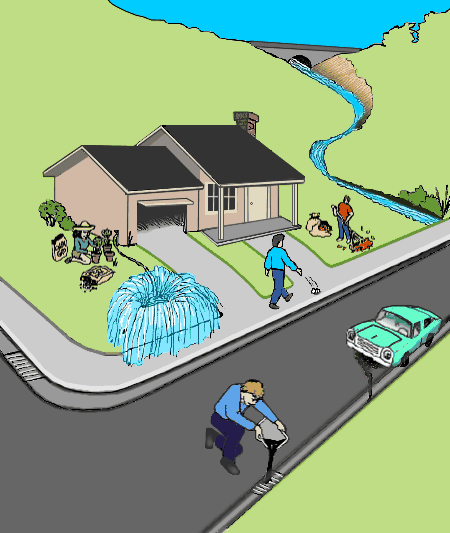
The Stream Banks Haven't Been Stabilized, and are Eroding!
Proper stabilization techniques can prevent stream bank erosion and addition of dirt to rivers.
Sometimes plants and trees are disturbed or moved during construction. When this happens, the soil that was underneath can be easily washed into nearby lakes and streams by rain or wind. Soil from eroding land that washed into steams makes the water look muddy and can smother aquatic life, clog fish gills, and cut off light that underwater plants need to grow. Help your community plant trees or leave native grasses and shrubs along a stream bank to reduce erosion. Plants prevent erosion by keeping soil where it belongs - on the land, and out of the water!
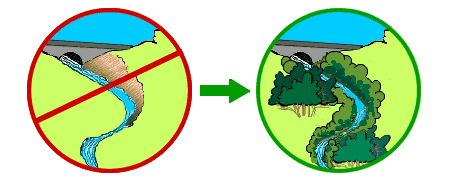
The Man is Raking Grass Clippings and Leaves into Plastic Bags!
Leave mowed grass clippings on the lawn as a source of nutrients for the grass, and to reduce erosion. You can also compost grass clippings and fallen leaves, and later use the compost to fertilize the soil.
Remember, the more that goes into your compost pile, the less that goes into the already overcrowded landfill!
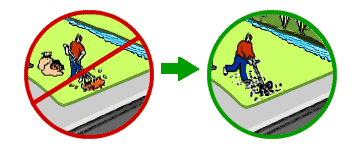
The Woman is Not Using Fertilizers and Pesticides Correctly for Her Garden!
Fertilizers contain large amounts of nutrients such as nitrogen and phosphorous that can wash into lakes and streams, and may cause algal blooms (overgrowth of aquatic plants that smother other aquatic life). These blooms use up the oxygen in the water that fish and other organisms need to breathe.
Pesticides (substances that kill bugs and animals) and herbicides (substances that kill weeds and plants) also contain toxic materials that are harmful to humans, fish, and "good" plants. When it rains, these toxic materials can run off into storm drains, roadside ditches, and nearby waterways.
Use fertilizers and pesticides properly. Ask to have your soil tested to determine the right amount and type of fertilizers you need. Never apply fertilizers before it is supposed to rain. Use organic fertilizers such as manure, mulch, or compost (see the information on proper disposal of yard wastes). Landscape with native plants (see information on Stream Bank Erosion prevention) that require less water and fewer pesticides.
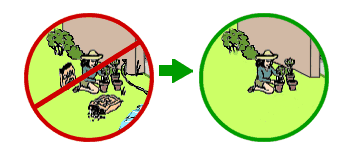
The Sprinkler is Watering the Sidewalk!
Place sprinklers so that the water goes ONLY on the lawn instead of watering the street or sidewalk.
Water the lawn or garden during the coolest part of the day, such as early in the morning, to reduce evaporation and increase the amount of water that sinks into the soil and reaches the plants' roots. Do not water on windy days, because water will be blown away and wasted.
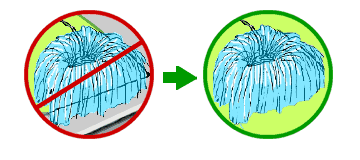
The Man is Throwing Litter into the Street!
Street litter, such as plastic bags, cups, and candy wrappers, often gets swept away with rain water into storm drains and ends up floating in the ocean or washing up on our beaches. A great deal of street litter is made up of plastic, which takes hundreds of years to break down and become harmless to the environment. Marine animals can mistake plastics for food and can become tangled up in it.
Recycle as much of your trash as possible, and put all other litter in garbage cans. Never throw trash in the street or down the storm drain. If you see trash on the ground, pick it up and toss it in the nearest trash can.

This Car is Leaking Oil and Antifreeze into the Street!
Oil and antifreeze that leaks out of cars is washed into storm drains when it rains. Check your cars for drips and leaks. If you find any, ask whomever is responsible for the car to have them fixed soon!

The Man is Pouring Motor Oil Down the Storm Drain!
Motor oil or antifreeze can damage or kill underwater plants animals.
Never pour used motor oil or antifreeze down a storm drain, onto the soil, or into a waterway. Put used oil or antifreeze in a sturdy container and take it to a local service station or other approved center.
Stencil "DUMP NO WASTE, DRAINS TO LAKE" (or river, or whatever) so others will know that allowing liquids other than storm water to get into the drain leads to pollution of lakes and streams.
